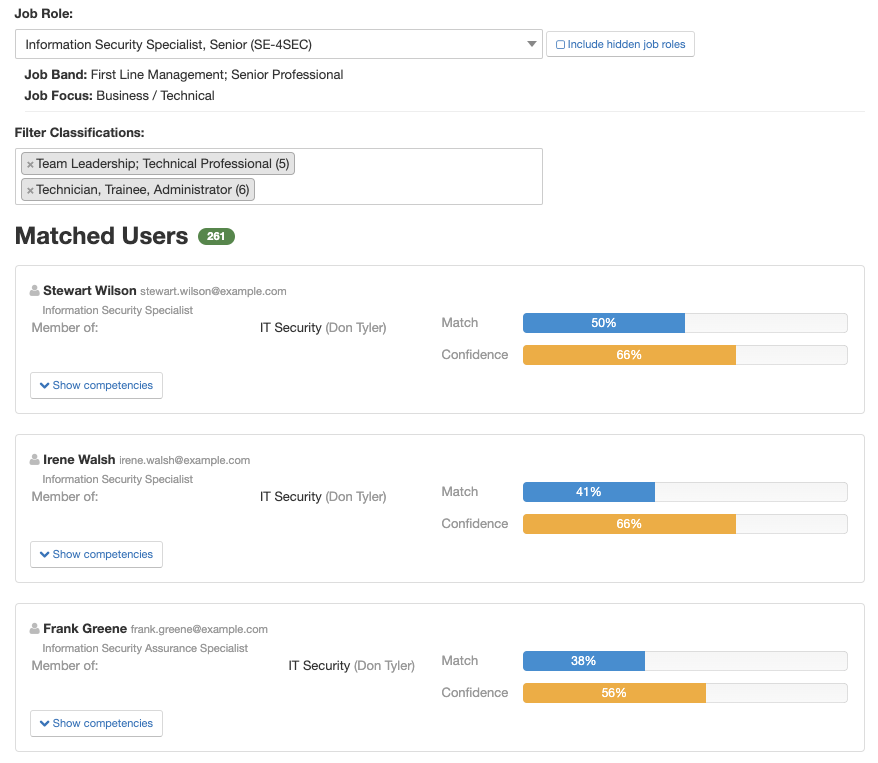Enabling Career Pathways with Technology
Steven Lowenthal
The Visibility Challenge
This article is a follow up on Part 4: Roles and Responsibilities for Modern Career Pathways:
At Lexonis, one of the common concerns that we hear is from organizations that engage in employee surveys who often receive employee feedback that there is no visibility of career development opportunities within the organization. This is not to say that there aren’t any, just that they are not made readily available and visible so that an employee can peruse their opportunity to fulfill their potential for their current employer. This often leads to frustration and potential retention as well as attraction issues. It is critical to make career development opportunities transparent to make this information easy to access and understand. A dynamic and visual representation of this information is ideal.

A skills-based approach and the technology to support it can offer several ways to represent this information. Why skills? For the reasons already described in this white paper, skills enable the organization to plot and deliver career development journeys beyond the traditional career steps that just using job titles offers. Using a skills-based approach enables lateral career moves – across job families and job grades – and truly supports talent mobility. Rich job and skills data require appropriate technology to support such an approach.
Career Pathway Views: Organizational vs. Personal
In the first instance, consider two potential career pathway views that we can make available:
- Organizational Career Pathways (see Figure 2)
- Personal Career Development Views (see Figure 4)
Organizational Career Pathways
This is a snapshot of a view from the Lexonis platform, other systems may provide something similar. This view represents what an organization-wide career pathway may look like for an Information Security Specialist, in this instance.

Figure 2: Example Lexonis career pathway representation
On the Lexonis platform, this view is flexible and may include more career stages (Short, Medium and Long Term), different labels and layers of potential jobs for consideration. Currently, someone who is an Information Security Specialist, may consider the Information Security Specialist, Senior role or the Information Security Administration Manager role, in the short term, and then contemplate their next career step beyond that, for instance, the Data Privacy Officer role in the medium term and into the future, the Chief Information Security Office role. On the Lexonis platform, each job has an associated skills-based job profile that articulates the skills and levels of proficiency required for success in that job. An individual employee can download and review each profile to understand the skills that they will need to develop for each stage of their career development. Note the color coding to denote different career tracks for the same job, this is useful for an organization endeavoring to provide opportunities for ‘knowledge workers’ alongside managerial/ leadership career paths. Such career pathway views can be built manually or automatically inferred by the Lexonis platform based on matching skills, job bands/grades or other criteria defined by the organization.
The Lexonis system also provides for additional information to be included in each job profile (or potentially job posting) that the organization may want to include to inform the employee on further career growth opportunities within their current role:

Figure 3: Visual career guidance information for managerial track.
In Figure 3, additional information has been provided to support someone interested in taking the managerial ‘route’.
Personal Career Development Views
As the name denotes, personal career development views personalize the career journey for the individual. These views require some form of assessment of the individual’s skills so that logic is used to identify which jobs they may be suited to based on their existing skills. Note Figure 4 and one view of this information provided by the Lexonis platform.

Figure 4: Suggested target jobs based on matching skills.
In this view, the employee (who is currently an Information Security Specialist) can quickly see a top 5 ‘hit list’ of other jobs they may be suited to for career development purposes, based on their existing skills. In this instance, they have targeted the Information Security Specialist, Senior role and added this to their development plan. The jobs suggested are not restricted by job family; it happens that the closest matching jobs are in the same domain of expertise but they do not necessarily have to be so if there are other jobs in the organization that are a good match for the employee’s current skill set. This approach is excellent in breaking down job silos and providing mobility in the organization. Note too, that the matching logic can be configured in the Lexonis platform to match the organization’s preferred criteria for driving career development.
In Figure 5, an employee has clear visibility of the skills that they have (shown as stars), against those that they require and the level at which they require them (shown as colored boxes) so that they can target the skills that they need to develop further for their career development. Further functionality enables each employee to build their Personal Development Plan (PDP) to support the development of their career in the direction that they would like to take.

Figure 5: Individual skill gap analysis for target job.
Aside from the organizational and personal views already described, it is also possible to take a far broader take on career development by providing the HR team with a view of potential candidates based on their matching skills. Note Figure 6, which displays potential cross-organizational candidates for the Information Security Specialist, Senior role.

Figure 6: Candidate analysis based on matching skills.
In this case, clicking the Show Competencies button provides a detailed view of which skills/competencies the person currently has in relation to those required for successful performance in the job. The added benefits of taking a skills-based approach once again means that job silos are broken down and it enables HR to take an objective and inclusive view of employees who are good fit for career growth into a new or vacant role, based on them having the necessary skills, not just their job title or job location.
Clearly, when made available, all these skills-based views address the issue of career development transparency and opportunity!
If you are interested in learning more, register for our upcoming webinar: Retain Top Talent with a Modern Approach to Career Pathways.
You may also like

There is a skills gap problem in the developed economies…

The business value of adopting a skills-based talent strategy and…

What is trending in workplace L&D this year? Are your…